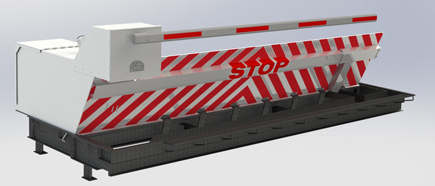The Ultimate Guide To Wedge Barriers
Facts About Wedge Barriers Revealed


18 may be done faster, easily, and expense effectively. FIG. In particular embodiments, the anchor 30 might be a steel structure consisting of plates, beam of lights(e. g., I-beams ), and/or various other frameworks that are safeguarded within the structure 14, which might be concrete. At the surface area 12, an upper side 28 of the support 30 might go to least partially revealed
, thus allowing the accessory of the obstacle 10 to the support 30. g., threaded holes)in one or more beam of lights or plates of the support 30 might be subjected to the surface area 12. In this manner, bolts 32 or other mechanical bolts might be utilized to protect the barrier 10 to the support 30. As the barrier 10 is installed to the surface area 12 of the foundation 14, collection of particles and other product below the obstacle might be minimized, and components of the bather 10 might not be exposed to listed below grade atmospheres. As shown by reference character 52, the lifting system 50 includes parts got rid of below the wedge plate 16. For instance, the elements 52 below the wedge plate 16 may include an electromechanical actuator, a web cam, one or even more camera surfaces, etc. Additionally, the lifting mechanism 50 consists of a springtime setting up 54
The springtime rod 58 is coupled to a webcam(e. g., webcam 80 revealed in FIG. 4) of the training mechanism 50. The springs 60 disposed regarding the spring pole 58 are kept in compression by spring sustains 62, consisting of a taken care of spring support 64. That is, the fixed springtime assistance 64 is dealt with about the structure 14 and the rest of the bather 10.
The smart Trick of Wedge Barriers That Nobody is Talking About
g., springtime assistance 65 )might be repaired to the end of the springtime pole 58 to allow compression of the springs 60. As the springtimes 60 are pressed in between the springtime sustains 62, the spring assembly 54 creates a pressure acting on the cam paired to the spring rod 58 in an instructions 66. As an example, the continuing to be force related to
the cam to release the wedge plate 16 might be provided by an electromechanical actuator 84 or various other actuator. The springtime assembly 54 and the actuator 84(e. g., electromechanical actuator)may run together to convert the camera and lift the wedge plate 16.
As discussed over, the springtime assembly 54 exerts a constant pressure on the cam, while the electromechanical actuator may be managed click site to exert a variable force on the webcam, thus allowing the lifting and lowering( i. e., deploying and withdrawing )of the wedge plate 16. In particular personifications, the constant force used by the springtime setting up 54 might be flexible. g., electromechanical actuator) is impaired. As will be valued, the spring setting up 54 may be covered and shielded from particles or other components by a cover plate(e. g., cover plate 68 received FIG. 4) that might be considerably flush with the elevated surface 38 of the foundation 14. As discussed above, in the deployed position, the wedge plate 16 serves to block gain access to or traveling past the barrier 10. For example, the barrier 10(e. g., the wedge plate 16 )may obstruct pedestrians or vehicles from accessing a building or path. As discussed over, the barrier 10 is attached to the anchor 30 safeguarded within the foundation 14,

front braces 71. As a result, the affiliation assemblies 72 might pivot and revolve to make it possible for the collapse and expansion of the linkage assemblies 72 throughout retraction and deployment of the bather 10. The linkage assemblies 72 cause motion of the wedge plate 16 to be restricted. If a vehicle is taking a trip in the direction of the released wedge plate 16(e. For example, in one situation, the safety legs 86 may be extended duringmaintenance of the barrier 10. When the safety and security legs 86 are released, the security legs 86 support the weight of the wedge plate 16 against the surface area 12. Therefore, the lifting mechanism 50 may be shut off, serviced, removed, replaced, etc. FIG. 5 is partial viewpoint sight of an embodiment of the surface-mounted wedge-style barrier 10, illustrating the cam 80 and the web cam surfaces 82 of the lifting device 50. Especially, two web cam surfaces 82, which are described as lower cam surfaces 83, are positioned listed below the cam 80. The reduced camera surfaces 83 might be repaired to the surface click here to find out more 12 (e. For instance, the reduced webcam surfaces 83 and the placing plate 85 may form a single piece that is secured to the support 30 by bolts or various other mechanical fasteners. Additionally, 2 cam surface areas 82, which are described as top webcam surface areas 87, are positioned over the web cam 80 and combined to (e. In various other personifications, intervening layers or plates might be positioned in between the surface 12 and the reduced camera surfaces 83 and/or the wedge plate 16 and the top cam surface areas 87 As discussed above, the camera
80 translates along the camera surface areas 82 when the wedge plate 16 is lifted from the withdrawed setting to the released position. In addition, as pointed out over, the spring setting up 54 (see FIG. 3 )may supply a force acting on the camera 80 in the direction 102 via spring pole 58, which might lower the pressure the electromechanical actuator 84 is required to apply to the cam 80 in order to actuate and raise the wedge plate 16. 1 )to the released position(see FIG. 4). As revealed, the camera 80 includes track wheels 104(e. g., rollers), which get in touch with and read convert along the cam surface areas 82 throughout procedure.